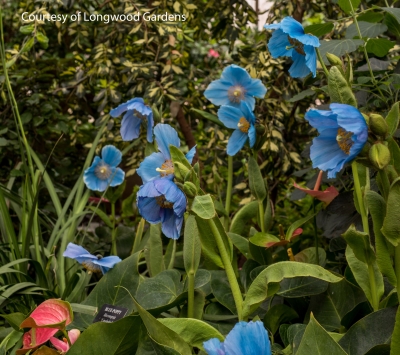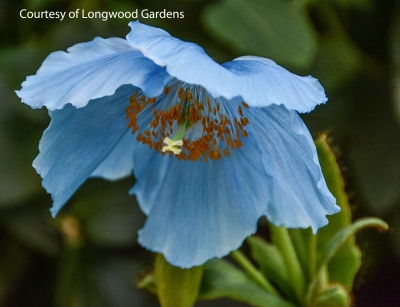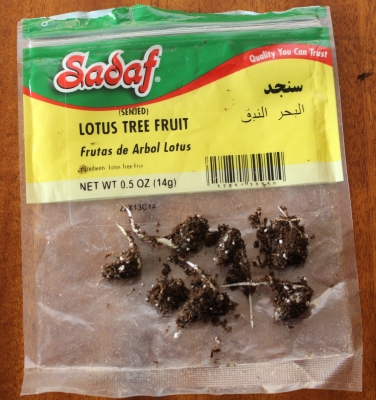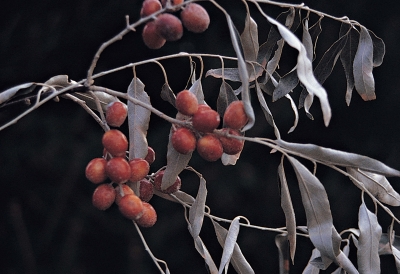ELUSIVE AZURE AND FRUIT
Too Hot Here For These Gems, But Maybe I Can Trick Them
It was decades ago that Norman — gardener, orchid expert, one-time cattle farmer, and lawyer — described to me his first sighting of blue poppy, Meconopsis betonicifolia. He was traveling in England, and at this particular garden was a pond whose far side was electrified by the sky blue petals of blue poppy, perhaps the purest blue of any flower. The mirrored surface of the water stepped up the voltage, as do the frilly clusters of golden anthers trembling in the center whorls of petals.
Since then, I’ve lusted for blue poppies but have yet to see the plant in bloom. Twice I tried to grow it, from seed. Each time the seedlings germinated and got off to a good start. Each time, in July, as temperatures here started to get steamy, the plants collapsed, dead. Blue poppy is native above 10,000 feet in the Himalayas and doesn’t like hot weather.
I don’t feel compelled to grow the plant (although that would be nice); I just want to feast my eyes on those bluest of blue petals. To see the plant in bloom requires being somewhere: 1) in late spring or early summer, 2) with cool summers, 3) where blue poppy grows wild or has been planted. The second condition, cool summers, is found in North America in the Pacific Northwest, New England and adjacent parts of Canada, and Alaska. I like hot summers so I’m not relocating to any of these places in order to grow this plant. Also, my garden is particularly needy and entrancing in late spring and early summer, so I’m not leaving then.
I Almost Cross Paths With Blue Poppy, After 20+ Years
As it turned out, I just missed an opportunity to see blue poppy in bloom at Longwood Gardens in Kennet Square, Pennsylvania. Not only is Longwood not far from here, but I happened to be in nearby Philadelphia two weeks ago, when the plant was in bloom. Who would have thought blue poppy could be grown in Pennsylvania? I had, at least, to find out how the plants are grown there. As described by Longwood horticulturalist Jim Harbage, each October Longwood has potted plants shipped from a nursery in Alaska. The plants are put into cold storage until early January, then brought into Longwood’s cool (50-60°F) conservatory to slowly awaken and, finally, blossom in March. After bloom, the plants, although perennials, are discarded.
I had, at least, to find out how the plants are grown there. As described by Longwood horticulturalist Jim Harbage, each October Longwood has potted plants shipped from a nursery in Alaska. The plants are put into cold storage until early January, then brought into Longwood’s cool (50-60°F) conservatory to slowly awaken and, finally, blossom in March. After bloom, the plants, although perennials, are discarded.
Most important is to keep temperatures below 70° F. Research at Longwood Gardens showed that respiration outpaces photosynthesis at warmer temperatures. The plant, essentially, starves. Warmer temperatures also cause some purpling of the petals, ruining the whole reason for growing the plant.
Could Longwood’s prescription be mimicked in my greenhouse? Probably not. Longwood’s large, high-ceilinged conservatory, with dappled shade from tree ferns and citrus trees, perhaps also cooling mists of water puffed into the air as needed, is a lot cooler than my greenhouse. Here, greenhouse temperatures on sunny days in February and March soar, despite vent fans, into the 80s.
How about a sunny window sill? Temperatures are cool in my house, more so the further you go from the woodstove. So that’s a possibility. But purchasing new plants every year could get expensive, especially plants that are good only for compost once their blossoms fade.
How about starting the seeds in early or mid winter for planting outdoors to blossom before temperatures get too hot? Or starting the seeds in fall and exposing the young seedings to very cool temperatures for more assured earlier blossoms outdoors? Blue poppy, if it behaves like many other perennials, should blossom the first season if started very early or if tricked into thinking it’s been through winter before blossoming. I later learned that Chanticleer Garden, also in the Philadelphia region, gets outdoor blossoms from plants purchased in October, wintered in cold frames, then planted outdoors in March. Bloom is in April; composting is in June.
The most important and most reliable route for me to eye blue poppy in bloom is to pencil in a trip to Longwood Gardens for early March next year.
King Red, For Fruit & Beauty, Also Elusive . . . Do Far
My blue poppy experience is reminiscent of my experience with another plant of western Asia, a plant variously called King Red Russian olive, iğde (in Turkey), botanically Elaeagnus angustifolia var. orientalis, or, erroneously, Trebizond date (which is a persimmon species).
King Red is invasive out West but definitely is not invasive here. As with blue poppy, I’ve grown the plant from seed only to have it collapse, dead, when steamy weather arrived.
Beautiful blossoms are not the attraction of King Red, although they do sweetly perfume the air in spring. Rather, it’s the bright red fruit that is highlighted by the gray-green foliage and, when dried, is like sweet talcum powder contained within a cherry-sized, brittle shell. Even without the flowers or fruit, the tree imparts a soft, Mediterranean look to the landscape, much like an olive tree, a relative.
I started some seedlings of King Red Russian olive last year, hoping for some genetic variability in heat tolerance. All the seedlings thrived, probably because of last summer’s relatively cool temperatures.
The seedlings are now dormant in 4 inch pots in my basement. I want 20 foot tall King Red trees so eventually the baby trees need to be planted out. I’m scoping out suitable locations with cooler microclimates. A spot receiving only morning sun is the current best candidate.
Perhaps in a few years I’ll be eating home-grown iğde while enjoying the sight of blue poppies.



